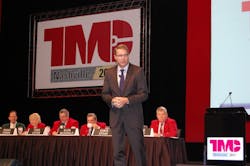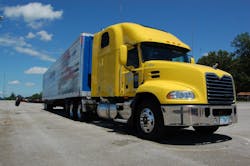To the eye of Chris Spear, president and CEO of the American Trucking Associations (ATA) trade group, there are a lot of regulatory battles ahead for the industry over the next several years, encompassing everything from developing the protocols governing autonomous vehicle operation to fighting against a mandate for speed limiters, and making changes to Phase 2 greenhouse gas (GHG) rules, such as removing the trailer mandate.
Yet all of those “big issues” also coincide with a number of “small topics” as well trucking needs to be involved with as well, Spear explained to Fleet Owner in an interview last week at the 2017 Technology & Maintenance Council (TMC) annual meeting – topics that could generate larger long-term impacts upon the industry if not addressed.
For example, Spear pointed to the ongoing debate regarding the Federal Communications Commission (FCC) assigning seven channels within the 5.9GHz radio band for “truck communication” protocols.
Reserving those channels for truck communication protocols would provide “wide open pathways” for vehicle-to-vehicle (V2V) connections, better autonomous truck navigation, and safety systems improvement for Class 8 trucks, he said.
“But does the FCC instead reserve some of those channels just to speed up Internet access for folks drinking coffee at the corner Starbucks? They are looking at sharing some of that space; that’s a question the FCC needs to figure out,” Spear noted.
He stressed, however, that if trucking gets allocated all of that 5.9GHz space, “then you are REALLY going to see innovation take off.”
That gets back to the larger question of autonomous vehicles and how soon driverless trucks will be operating on U.S. roads. While Spear said
ATA thinks that the widespread adoption of autonomous vehicle technology “is literally 20 to 25 years away, the debate over how it’s going to look and how it’s going to feel is happening right now. We all need to be doing our homework [on this issue] now.”
Part of that “homework” is how the use of autonomous technology could impact hours of service (HOS) rules. From Spear’s point of view, “it is really going to be about ‘driver-assist’ and not ‘driverless’ when we discuss autonomous technology, so the question then becomes how will such ‘Level 2 &3’ systems count against HOS?”
Much of such regulatory focus on ATA’s part will be about “defining ROI” or return on investment from such technological developments and the rules governing them, Spear added.
“Doing our homework now is about determining the potential ROI and then getting the federal government out of the way so we can unleash innovation,” he stressed.
To that end, Mike Cammisa, ATA’s vice president of safety policy and connectivity, laid out a near-term “roadmap” at TMC’s annual meeting detailing the many different policy and regulatory efforts topping the trade group’s “to do” list for this year:
Automated Trucks: ATA’s Spear is currently a member of the Department of Transportation (DOT) Advisory Committee on Automation in Transportation, which met for the first time in January this year. He also served on a similar panel organized by the Federal Motor Carrier Safety Administration (FMCSA), which expects to issue “guidelines” for driverless trucks by the end of 2017. However, as both of these initiatives got started during the Obama administration, they may undergo changes under Trump’s administration and DOT Secretary Elaine Chao.About the Author
Sean Kilcarr
Editor in Chief
Sean Kilcarr is a former longtime FleetOwner senior editor who wrote for the publication from 2000 to 2018. He served as editor-in-chief from 2017 to 2018.


